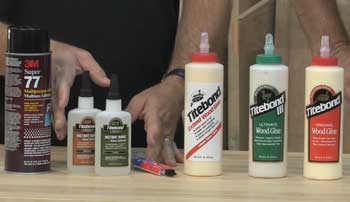The glue will ensure that your butcher block remains stable and does not move or come loose over time. If your surface is not glued down, it may also start to show signs of wear and tear – including cracks in the surface – due to frequent use.
Now, what’s on your mind? You may be looking for the best glue for butcher block countertop? Don’t worry. This article will discuss some of the best glue for butcher blocks countertops such as Titebond Glue and Titebond iii Ultimate Wood Glue.
Butcher Block Countertop Adhesive- Titebond III

When it comes to woodworking, nothing is more important than accuracy. That’s why this article has chosen Titebond III as our go-to adhesive for all your woodworking needs. This superior waterproof wood glue is ideal for exterior and interior woodworking, allowing you to achieve precise and accurate results time after time. With a clamps application temperature of as low as 47° F and an eight-minute open time, this glue is sure to meet your needs.
Want to know more about titebond iii gallons, titebond iii dry times, titebond 3 vs 2 then click here
How To Remove Dried Titebond III Glue
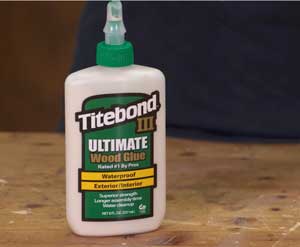
Remove dried titebond iii glue in a safe and clean way. Use acetone or any other solvent to remove the glue. Be careful not to inhale fumes from the solvent. Once all of the glue has been removed, use abrasive sandpaper or steel wool to roughen up the surface where the adhesive was applied. This will help prevent future sticking and provide an easier removal process when needed.
Alternatively, you can use a scraper to gently remove the dried adhesive. Wet the area with water first and then scrape away at the glue until it is gone.
What Happens If Titebond III Freezes

If titebond III freezes, it will usually be in the form of small ice crystals. These crystals can easily become lodged between the fibers of the plywood and cause damage. If this happens, you may notice that there is a noticeable noise when you touch or move the plywood and it may also show signs of cracking or separation.
If this is the case, it is important to remove the frozen crystals as quickly as possible using a heat gun or oven. In extreme cases, if there are large ice crystals present, they may actually break off of the plywood and cause serious damage.
What Is A Wood Countertop?

Wood countertops are the perfect way to update your kitchen look without having to spend a fortune. They’re very affordable, easy to install and come in a variety of styles and colors so you can find the perfect one for your room.
There are a few things to keep in mind when choosing a wood countertop. First, make sure the material is compatible with your existing cabinet and counter types. Second, be sure to select the right width for your kitchen space.
And finally, choose a top that will fit your needs–some may require extra-thick boards or hidden fasteners for stability. With a little bit of research, you’ll be able to find the perfect wood countertop for your kitchen.
Butcher Block Wood Counter

Butcher block wood counters are a popular form of kitchen countertops. These counters are made from large blocks of oak or hickory that have been specially sanded and finished to create a smooth surface. Butcher block wood is the most traditional type of kitchen countertop, but other types of wood such as maple and walnut are also available.
Butcher block wood is perfect for kitchens with high-end aesthetics because it has a rustic look that can be accentuated with various types of finishes. However, it is not as durable as other types of countertops, so it should be treated with care.
Some important features to consider when choosing a butcher block wood countertop include the size and shape of the block, the type of finish available, and whether or not there are any additional accessories available.
What Wood Is Best For Butcher Block Countertops?
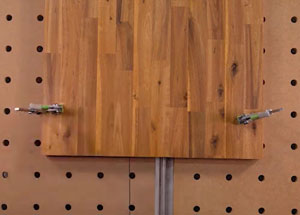
Maple is a popular wood for butcher block countertops because it has a beautiful grain that can be highlighted with various types of finishes. However, hickory is also a good choice if you want a more rustic look.
How To Glue Two Pieces Of Butcher Block Together
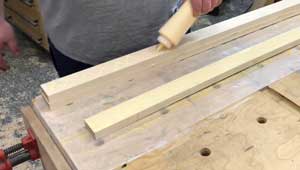
There is no one correct way to glue two pieces of butcher block together – it all depends on the specificities of your block. Some methods that may work include using a wood filler, sanding down the joints, and then applying a protective finish, or using a special glue designed specifically for butcher blocks.
How To Join Butcher Block Countertops In A Corner
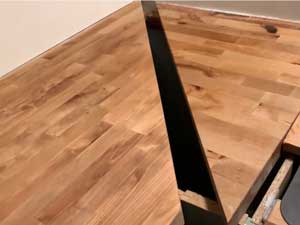
Joining butcher block countertops in a corner can be a bit challenging because the blocks are usually not entirely square. One method that may work is to use a jigsaw to cut out a V-shaped piece of wood that will fit into the corner. After cutting the pieces, glue them together and then sand down the edges so they’re smooth.
Joining Butcher-block With Pocket Screws
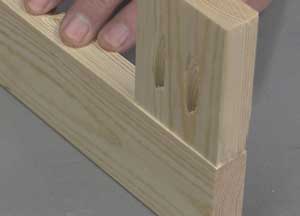
Pocket screws are a type of screw that is designed for use with wood that doesn’t have a lot of mass – like butcher block. Because the screw heads are small, they tend to grip the wood better and resist movement.
To join two pieces of butcher block using pocket screws, start by drilling pilot holes through both boards. Next, drive in the pocket screws about one inch (2.5 cm) into each board. Make sure the screws are tight – you don’t want them coming loose later on. Finally, use a hammer to tap the screws slightly into the wood until they’re flush with the surface.
Joining Butcher-block With Kreg Jig
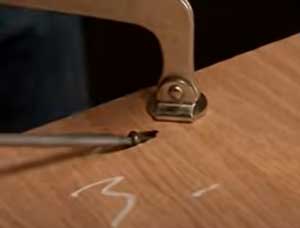
Kreg jigs are a type of tool that can be used to join pieces of wood together. They come in a variety of shapes and sizes, so they’re perfect for use with butcher block.
To join two pieces of butcher block using a Kreg jig, start by cutting the boards into the appropriate shape. Next, affix the angles onto one end of the jig – this will help you hold the piece together while you drill the screw hole.
Once the hole is drilled, insert the screws and tighten them down. You can also use a wrench to help twist the screws as you tighten them in place.
Best Sink For Butcher Block Countertop

Undermount sink is the best sink for butcher block countertop. This type of sink is perfect for use with butcher block. Undermount sinks feature a shallow depth, so they won’t take up too much counter space. They’re also easy to clean – just soap and water will do the trick.
Some other benefits of under-mount sinks include their noise levels – they are typically quite low-profile, so you won’t hear them running when you’re cooking or mixing ingredients. And last but not least, undermount sinks are typically less expensive than other types of sinks.
How To Hide Seams In Butcher Block Countertops
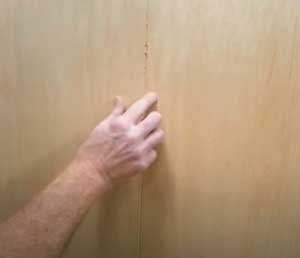
If you’re looking to disguise the seams in your butcher block countertops, there are a few options available to you. One option is to use a wood filler or patching compound. This will help hide any imperfections on the surface of the countertop and make it look seamless.
Another option is to add an overlay – this will create a seemingly solid piece of butcher block that can be painted or covered in some other type of finish. Overlays are usually more expensive than wood fillers or patches, but they can give your countertop a more high-end look.
What Is The Difference Between Butcher Block And Wood Countertops?
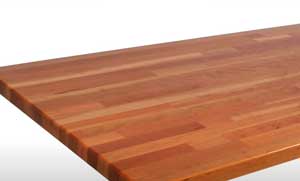
There are a few key differences between butcher block and wood countertops. First of all, butcher block is made from different types of wood – typically hickory or oak. This makes the surface much more durable than traditional wooden countertops, which can often be scratched or damaged relatively easily.
Butcher block also has a depth to it – meaning that the surface is deeper than normal countertops so it can hold more weight (e.g., utensils and pots). This makes it perfect for use as a butcher block countertop, as the surface is already configured to hold all of your tools and ingredients.
In addition to these differences, wood countertops typically have a more natural look than those made from other materials. Butcher block countertops can be treated with sealant or wax to give them a similar appearance, but they will usually still have some visible seams.
FAQ
Is Butcher Block Real Wood?
No, butcher block is not real wood. It is a type of countertop made from hickory or oak boards that are then finished to give it the look and feel of real wood.
Is Hevea Wood Good For Butcher Block?
There is no one-size-fits-all answer to this question, as the quality and finish of the Hevea butcher block will vary depending on the brand and model. However, generally speaking, Hevea butcher blocks are a good option for those looking for a high-quality countertop that will last long into the future.
Are Butcher Blocks Worth It?
That depends on your needs and preferences. But overall, a butcher block countertop is a classic option that can add some extra value and appeal to your kitchen décor. However, it is important to consider your budget and expectations before making a purchase.
Conclusion
Glue is a very important thing when making butcher block countertops. If you don’t use good type glue, you won’t get the best performance from the countertop.
This article has highlighted two types of best glue for butcher block countertop. You can blindly choose one of them. If you have any questions in your mind, comment below.

